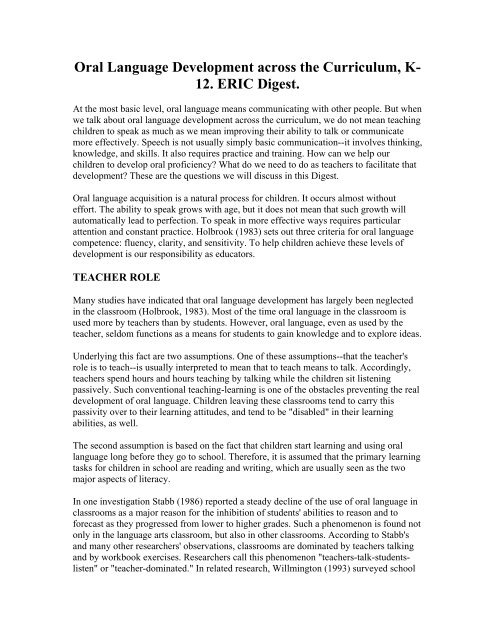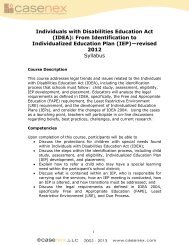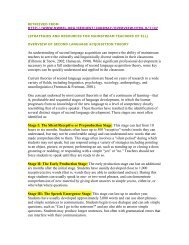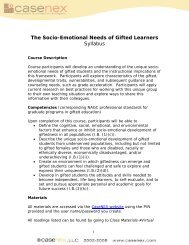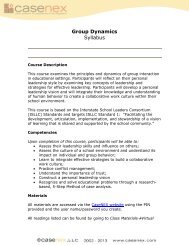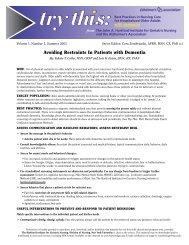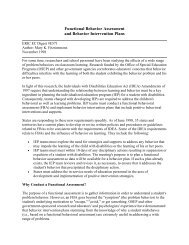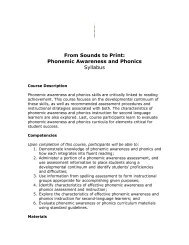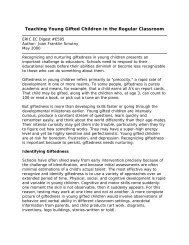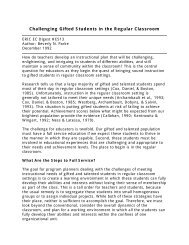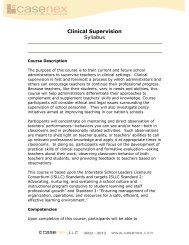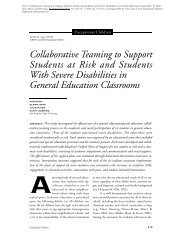Oral Language Development across the Curriculum, K ... - Casenex
Oral Language Development across the Curriculum, K ... - Casenex
Oral Language Development across the Curriculum, K ... - Casenex
Create successful ePaper yourself
Turn your PDF publications into a flip-book with our unique Google optimized e-Paper software.
<strong>Oral</strong> <strong>Language</strong> <strong>Development</strong> <strong>across</strong> <strong>the</strong> <strong>Curriculum</strong>, K-<br />
12. ERIC Digest.<br />
At <strong>the</strong> most basic level, oral language means communicating with o<strong>the</strong>r people. But when<br />
we talk about oral language development <strong>across</strong> <strong>the</strong> curriculum, we do not mean teaching<br />
children to speak as much as we mean improving <strong>the</strong>ir ability to talk or communicate<br />
more effectively. Speech is not usually simply basic communication--it involves thinking,<br />
knowledge, and skills. It also requires practice and training. How can we help our<br />
children to develop oral proficiency? What do we need to do as teachers to facilitate that<br />
development? These are <strong>the</strong> questions we will discuss in this Digest.<br />
<strong>Oral</strong> language acquisition is a natural process for children. It occurs almost without<br />
effort. The ability to speak grows with age, but it does not mean that such growth will<br />
automatically lead to perfection. To speak in more effective ways requires particular<br />
attention and constant practice. Holbrook (1983) sets out three criteria for oral language<br />
competence: fluency, clarity, and sensitivity. To help children achieve <strong>the</strong>se levels of<br />
development is our responsibility as educators.<br />
TEACHER ROLE<br />
Many studies have indicated that oral language development has largely been neglected<br />
in <strong>the</strong> classroom (Holbrook, 1983). Most of <strong>the</strong> time oral language in <strong>the</strong> classroom is<br />
used more by teachers than by students. However, oral language, even as used by <strong>the</strong><br />
teacher, seldom functions as a means for students to gain knowledge and to explore ideas.<br />
Underlying this fact are two assumptions. One of <strong>the</strong>se assumptions--that <strong>the</strong> teacher's<br />
role is to teach--is usually interpreted to mean that to teach means to talk. Accordingly,<br />
teachers spend hours and hours teaching by talking while <strong>the</strong> children sit listening<br />
passively. Such conventional teaching-learning is one of <strong>the</strong> obstacles preventing <strong>the</strong> real<br />
development of oral language. Children leaving <strong>the</strong>se classrooms tend to carry this<br />
passivity over to <strong>the</strong>ir learning attitudes, and tend to be "disabled" in <strong>the</strong>ir learning<br />
abilities, as well.<br />
The second assumption is based on <strong>the</strong> fact that children start learning and using oral<br />
language long before <strong>the</strong>y go to school. Therefore, it is assumed that <strong>the</strong> primary learning<br />
tasks for children in school are reading and writing, which are usually seen as <strong>the</strong> two<br />
major aspects of literacy.<br />
In one investigation Stabb (1986) reported a steady decline of <strong>the</strong> use of oral language in<br />
classrooms as a major reason for <strong>the</strong> inhibition of students' abilities to reason and to<br />
forecast as <strong>the</strong>y progressed from lower to higher grades. Such a phenomenon is found not<br />
only in <strong>the</strong> language arts classroom, but also in o<strong>the</strong>r classrooms. According to Stabb's<br />
and many o<strong>the</strong>r researchers' observations, classrooms are dominated by teachers talking<br />
and by workbook exercises. Researchers call this phenomenon "teachers-talk-studentslisten"<br />
or "teacher-dominated." In related research, Willmington (1993) surveyed school
administrators who attested to <strong>the</strong> importance of oral communication skills for teachers--<br />
and <strong>the</strong>y considered listening to be <strong>the</strong> most important skill of all.<br />
Ano<strong>the</strong>r result of teacher-dominated classrooms is <strong>the</strong> negative effect upon children's<br />
attitudes toward learning. Operating under <strong>the</strong> two above-mentioned assumptions,<br />
teachers often fail to see that literacy learning is a continuum--an ongoing process of<br />
learning--for children. Learning before going to school and learning in school are often<br />
viewed as separate processes. <strong>Oral</strong> language, which is <strong>the</strong> major learning instrument for<br />
children before going to school, is no longer available with <strong>the</strong> onset of formal schooling.<br />
Confronted with new tasks of learning to read and write while being deprived of <strong>the</strong>ir<br />
major learning tool, children tend to feel depressed and frustrated. Learning begins to<br />
loom large, and schooling gradually becomes routine--exactly <strong>the</strong> situation described in<br />
Stabb's research.<br />
After a few years students will have become programmed to a kind of passive learning<br />
atmosphere--<strong>the</strong> teacher talks, <strong>the</strong> students listen and do <strong>the</strong>ir homework. Here, learning<br />
simply means taking down whatever is given. In this type of classroom environment,<br />
students learn <strong>the</strong> basic skills of reading and writing. However, <strong>the</strong>y will not learn how to<br />
think critically and how to make sound judgments on <strong>the</strong>ir own.<br />
Stabb (1986) speculates that we teachers often become "so involved with establishing<br />
routine, finishing <strong>the</strong> textbook, covering curriculum, and preparing students for<br />
standardized tests that we have forgotten one of our original goals, that of stimulating<br />
thought." Though Stabb's speculation sounds critical, she does provide us with a thoughtprovoking<br />
expansion of <strong>the</strong> relationship between oral language development and thinking<br />
abilities development. In delineating a debate program for elementary school students,<br />
Aiex (1990) notes that, although <strong>the</strong> focus of <strong>the</strong> program is on <strong>the</strong> development of oral<br />
communication skills, critical thinking and reasoning abilities are also developed along<br />
<strong>the</strong> way.<br />
ORAL LANGUAGE AS FOUNDATION<br />
From <strong>the</strong> preceding, we can see that oral language is indeed an important link in <strong>the</strong><br />
process of children's learning and thinking development. It is not merely a language<br />
issue; it is also an intellectual issue which deserves serious attention from both teachers<br />
and researchers. From <strong>the</strong> perspective of language development, oral language provides a<br />
foundation for <strong>the</strong> development of o<strong>the</strong>r language skills. For most children, <strong>the</strong> literacy<br />
learning process actually begins with speaking--talking about <strong>the</strong>ir experiences, talking<br />
about <strong>the</strong>mselves. It is through speech that children learn to organize <strong>the</strong>ir thinking and<br />
focus <strong>the</strong>ir ideas (Lyle, 1993). The neglect of oral language in <strong>the</strong> classroom will destroy<br />
that foundation and severely hinder <strong>the</strong> development of o<strong>the</strong>r aspects of language skills.<br />
RESEARCH ON COGNITIVE DEVELOPMENT<br />
Current research literature on critical thinking and cognitive development indicates that<br />
<strong>the</strong> development of language has a close relationship to <strong>the</strong> development of thinking
abilities (Berry, 1985; Gambell, 1988). This is especially true for elementary-level<br />
students. Before achieving proficiency in reading and writing--and even after proficiency<br />
in reading and writing have been achieved--oral language is one of <strong>the</strong> important means<br />
of learning and of acquiring knowledge (Lemke, 1989). Throughout life, oral language<br />
skills remain essential for engagement in intellectual dialogue, and for <strong>the</strong><br />
communication of ideas.<br />
TEACHER AS FACILITATOR<br />
Given this understanding of <strong>the</strong> importance of oral language skills, we should reflect on<br />
our attitudes toward <strong>the</strong> teaching-learning relationship. First of all, we need to overcome<br />
<strong>the</strong> faulty assumptions mentioned before. As teachers, we should not assume <strong>the</strong> role of<br />
authoritarian knowledge giver. Instead, we should see ourselves as friendly and interested<br />
facilitators of student learning. In emphasizing <strong>the</strong> role of oral language in <strong>the</strong> classroom,<br />
we are by no means implying that <strong>the</strong> teacher's role is not important; on <strong>the</strong> contrary, we<br />
present a more demanding task for teachers. To facilitate a learning process in which<br />
children are given both opportunity and encouragement to speak and to explore <strong>the</strong>ir own<br />
thinking, <strong>the</strong> teacher has to do more than tell children what he or she means, or what <strong>the</strong><br />
text means. Instead, <strong>the</strong> teacher has several different roles to play.<br />
The teacher can encourage students to bring <strong>the</strong>ir ideas and background knowledge into<br />
class learning activities. To achieve this goal, <strong>the</strong> teacher must be a good and responsive<br />
listener to children's talk. Facilitation of a child's talking in class is not enough for<br />
language teaching, however, but only provides an environment conducive to both<br />
teaching and learning. At this point, <strong>the</strong> teacher can raise questions concerning <strong>the</strong><br />
content of <strong>the</strong> class or <strong>the</strong> text. While maintaining <strong>the</strong> role of a knowing arbiter, <strong>the</strong><br />
teacher still needs to persuade <strong>the</strong> students. Here one point should be emphasized--<br />
implementation of oral language development <strong>across</strong> <strong>the</strong> curriculum requires teamwork.<br />
All content-area teachers have to be actively involved in this task. The goal is not only to<br />
get children to speak, but also to have <strong>the</strong>m learn and develop through speech.<br />
As <strong>the</strong> children's o<strong>the</strong>r language skills develop in <strong>the</strong> course of time, classroom talk can<br />
be directed more towards <strong>the</strong> goals of exploring ideas found in texts and sharpening<br />
thoughts. "Speaking to learn" is <strong>the</strong> vehicle for increasing and deepening knowledge.<br />
Two publications recommended as resource guides for classroom teachers are<br />
"Guidelines for Developing <strong>Oral</strong> Communication Curricula in Kindergarten through<br />
Twelfth Grade" and "Listening and Speaking in <strong>the</strong> English <strong>Language</strong> Arts Curricula K-<br />
12."<br />
REFERENCES<br />
Aiex, Nola Kortner (1990). "Debate and Communication Skills." ERIC Digest.<br />
Bloomington, IN: ERIC Clearinghouse on Reading, English, and Communication. [ED<br />
321 334]
Berry, Kathleen S. (1985). "Talking to Learn Subject Matter/Learning Subject Matter<br />
Talk." <strong>Language</strong> Arts, 62(1), 34-42. [EJ 309 762]<br />
Gambell, Trevor J. (1988). "Linguistics and Literacy Teaching." Paper presented at <strong>the</strong><br />
World Conference of Applied Linguistics (Sydney, Australia). [ED 299 816]<br />
Guidelines for Developing <strong>Oral</strong> Communication Curricula in Kindergarten through<br />
Twelfth Grade (1991). Annandale, VA: Speech Communication Association. [ED 337<br />
828]<br />
Holbrook, Hilary Taylor (1983). "ERIC/RCS Report: <strong>Oral</strong> <strong>Language</strong>: A Neglected<br />
<strong>Language</strong> Art?" <strong>Language</strong> Arts, 60(2), 255-58. [EJ 276 124]<br />
Lemke, J. L. (1989). "Making Text Talk." Theory-into-Practice, 28(2), 136-41. [EJ 415<br />
815]<br />
Listening and Speaking in <strong>the</strong> English <strong>Language</strong> Arts <strong>Curriculum</strong> K-12. 1989 Field Test<br />
Edition. Albany, NY: New York State Education Department. [ED 335 726]<br />
Lyle, Susan (1993). "An Investigation into Ways in Which Children Talk Themselves<br />
into Meaning." <strong>Language</strong> and Education, 7(3), 181-87. [EJ 485 116]<br />
Stabb, Claire (1986). "What Happened to <strong>the</strong> Sixth Graders: Are Elementary Students<br />
Losing Their Need to Forecast and to Reason?" Reading Psychology, 7(4), 289-96. [EJ<br />
348 985]<br />
Willmington, S. Clay (1993). "<strong>Oral</strong> Communication Skills Necessary for Successful<br />
Teaching." Educational Research Quarterly, 16(2), 5-10. [EJ 480 434]<br />
ERIC Identifier: ED389029<br />
Publication Date: 1995-00-00<br />
Author: Zhang, Hong - Alex, Nola Kortner<br />
Source: ERIC Clearinghouse on Reading English and Communication Bloomington IN.<br />
ERIC Digests are in <strong>the</strong> public domain and may be freely reproduced and disseminated. However, all o<strong>the</strong>r information<br />
on this site is copyrighted and may not be used without permission.


